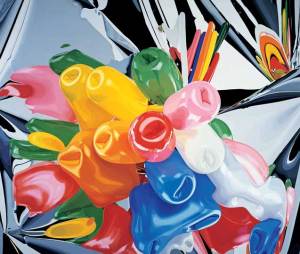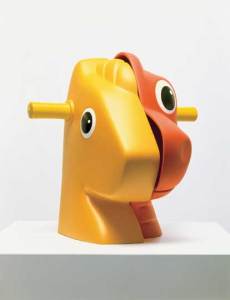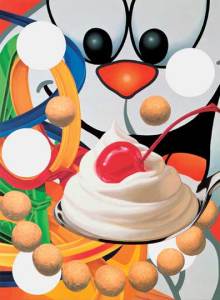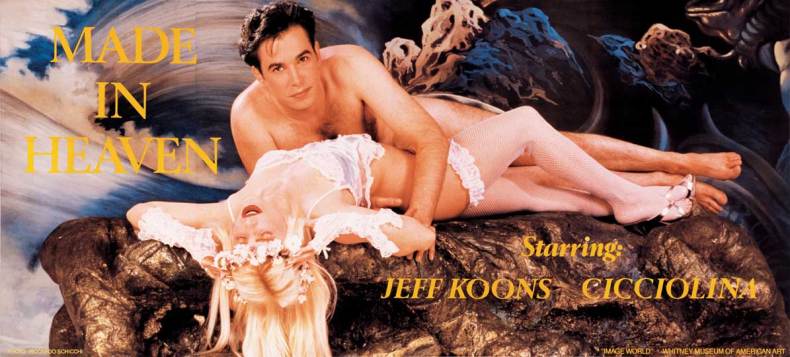‘Let there be art! Let there be Koons!’ is how Adam Weinberg, Director of New York’s Whitney Museum of American Art, wrapped up the over-excited press call for the Jeff Koons retrospective, the museum’s swansong exhibition in its Upper East Side building before moving downtown to the Meatpacking district, into a Renzo Piano steel and glass building to open next spring.

Tulips (1995–98), Jeff Koons. Private collection © Jeff Koons
In the crushed museum basement it seemed that every New York art critic, mostly dressed in regulation black despite it being June, had braved the hot, humid afternoon to attend the momentous event. Koons’s Tulips (1995–98), a big canvas offering a riot of optimistic colour, hung on the wall to the right; his big black granite sculptures Popeye (2009–12) and Woman Reclining (2010–14) stood in the garden to the left. An abundance of museum security hovered at doorways.

Split-Rocker (Orange/Red) (1999), Jeff Koons. Collection of B. Z. and Michael Schwartz © Jeff Koons
Koons was there, too, dapper in sharp suit, open-neck white shirt, precision-cut short hair, looking for all the world like a Wall Street trader – which indeed he was in the 1980s. He claims ‘the market is the greatest critic’. The world’s most expensive living artist – close to 150 of whose works filled the Whitney’s galleries above us with an estimated collective value of ‘close to $1 billion’ – spoke economically. Noting the Whitney is an important platform for ‘young artists to interact with art’, he revealed his own interaction with art. ‘I’m 59 years of age right now and I want to share my art. The Whitney is a platform for this. I’m enjoying every moment because I believe in art.’ He expanded that art has ‘taught me how to feel, how to enjoy ideas and experiences, to become a better human being. I believe completely in the work you find here’, concluding with his intention to ‘exercise the freedom as an individual to do what I want’ for the next three decades, or more.

Loopy (1999), Jeff Koons. Bill Bell Collection © Jeff Koons
The exhibition is indeed a considerable achievement for the Whitney – of borrowing from a plethora of private lenders, of installing huge pieces whose mirror-smooth surfaces could easily be scratched, and of liaising with Koons. Weinberg, after briefly noting that Koons first visited the Whitney aged 19, has been exhibited there multiple times and has lived and worked in New York since the ‘70s, got to the crux of the problem. It was ‘no surprise’ that he had never been given a retrospective by the city, he said, because ‘it is no small feat to satisfy his exacting standards. … How these works made it to their precise position in the gallery is, frankly, astonishing. … This has been a great Koonsian adventure!’ However, his praise was undiminished by the experience: ‘If Jeff Koons did not exist we’d have to invent him. His art is emblematic of our times.’
And with that we dispersed, each on our own ‘Koonsian adventure’. As we explored five floors of works made from 1978 to today and arranged chronologically from the basement up, journalists young and old got busy not so much looking at the art as snapping selfies and each other in front of the best known pieces. Thus, not so many clicks in front of the Dali- and Duchamp-influenced 1970s inflatables; more among the 1985 Equilibrium series, his first solo show, which included baseballs apparently hovering in space in tanks (a trick achieved with the help of Nobel prize-winning physicist Richard Feynman); and a short queue beside the 10-foot-tall steel Balloon Dog (Yellow) (1994–2000) made in 60 precision-engineered parts in a specialist foundry in California. Doubtless, the limited edition Balloon Dog (Yellow) handbag created by the retailor H&M in collaboration with the Whitney and Koons, to go on sale on 17 July, will be an instant sell-out and a big E-Bay ticket.

Made in Heaven (1989), Jeff Koons Tate and the National Galleries of Scotland. Acquired jointly through The d’Offay Donation with assistance from the National Heritage Memorial Fund and Art Fund 2008 © Jeff Koons
‘Jeff Koons: A Retrospective’ is at the Whitney Museum of American Art, New York, from 27 June – 19 October. It then travels to the Centre Pompidou, Paris, 26 November 2014–27 April 2015; and the Guggenheim Museum Bilbao, Spain, 5 June–27 September, 2015.
Jeff Koons’s Split Rocker, a 37-foot-high sculpture with 50,000 flowering plants, is on exhibition at New York’s Rockefeller Center from 25 June–12 September.
Related Articles
Bubbles: are steel balloons the new tulip paintings? (Maggie Gray)
Moving the Museum: the Whitney’s new building (Jack Orlik)

A ‘Koonsian Adventure’: Jeff Koons at the Whitney
Balloon Dog (Yellow) (1994–2000), Jeff Koons. Private collection © Jeff Koons
Share
‘Let there be art! Let there be Koons!’ is how Adam Weinberg, Director of New York’s Whitney Museum of American Art, wrapped up the over-excited press call for the Jeff Koons retrospective, the museum’s swansong exhibition in its Upper East Side building before moving downtown to the Meatpacking district, into a Renzo Piano steel and glass building to open next spring.
Tulips (1995–98), Jeff Koons. Private collection © Jeff Koons
In the crushed museum basement it seemed that every New York art critic, mostly dressed in regulation black despite it being June, had braved the hot, humid afternoon to attend the momentous event. Koons’s Tulips (1995–98), a big canvas offering a riot of optimistic colour, hung on the wall to the right; his big black granite sculptures Popeye (2009–12) and Woman Reclining (2010–14) stood in the garden to the left. An abundance of museum security hovered at doorways.
Split-Rocker (Orange/Red) (1999), Jeff Koons. Collection of B. Z. and Michael Schwartz © Jeff Koons
Koons was there, too, dapper in sharp suit, open-neck white shirt, precision-cut short hair, looking for all the world like a Wall Street trader – which indeed he was in the 1980s. He claims ‘the market is the greatest critic’. The world’s most expensive living artist – close to 150 of whose works filled the Whitney’s galleries above us with an estimated collective value of ‘close to $1 billion’ – spoke economically. Noting the Whitney is an important platform for ‘young artists to interact with art’, he revealed his own interaction with art. ‘I’m 59 years of age right now and I want to share my art. The Whitney is a platform for this. I’m enjoying every moment because I believe in art.’ He expanded that art has ‘taught me how to feel, how to enjoy ideas and experiences, to become a better human being. I believe completely in the work you find here’, concluding with his intention to ‘exercise the freedom as an individual to do what I want’ for the next three decades, or more.
Loopy (1999), Jeff Koons. Bill Bell Collection © Jeff Koons
The exhibition is indeed a considerable achievement for the Whitney – of borrowing from a plethora of private lenders, of installing huge pieces whose mirror-smooth surfaces could easily be scratched, and of liaising with Koons. Weinberg, after briefly noting that Koons first visited the Whitney aged 19, has been exhibited there multiple times and has lived and worked in New York since the ‘70s, got to the crux of the problem. It was ‘no surprise’ that he had never been given a retrospective by the city, he said, because ‘it is no small feat to satisfy his exacting standards. … How these works made it to their precise position in the gallery is, frankly, astonishing. … This has been a great Koonsian adventure!’ However, his praise was undiminished by the experience: ‘If Jeff Koons did not exist we’d have to invent him. His art is emblematic of our times.’
And with that we dispersed, each on our own ‘Koonsian adventure’. As we explored five floors of works made from 1978 to today and arranged chronologically from the basement up, journalists young and old got busy not so much looking at the art as snapping selfies and each other in front of the best known pieces. Thus, not so many clicks in front of the Dali- and Duchamp-influenced 1970s inflatables; more among the 1985 Equilibrium series, his first solo show, which included baseballs apparently hovering in space in tanks (a trick achieved with the help of Nobel prize-winning physicist Richard Feynman); and a short queue beside the 10-foot-tall steel Balloon Dog (Yellow) (1994–2000) made in 60 precision-engineered parts in a specialist foundry in California. Doubtless, the limited edition Balloon Dog (Yellow) handbag created by the retailor H&M in collaboration with the Whitney and Koons, to go on sale on 17 July, will be an instant sell-out and a big E-Bay ticket.
Made in Heaven (1989), Jeff Koons Tate and the National Galleries of Scotland. Acquired jointly through The d’Offay Donation with assistance from the National Heritage Memorial Fund and Art Fund 2008 © Jeff Koons
‘Jeff Koons: A Retrospective’ is at the Whitney Museum of American Art, New York, from 27 June – 19 October. It then travels to the Centre Pompidou, Paris, 26 November 2014–27 April 2015; and the Guggenheim Museum Bilbao, Spain, 5 June–27 September, 2015.
Jeff Koons’s Split Rocker, a 37-foot-high sculpture with 50,000 flowering plants, is on exhibition at New York’s Rockefeller Center from 25 June–12 September.
Related Articles
Bubbles: are steel balloons the new tulip paintings? (Maggie Gray)
Moving the Museum: the Whitney’s new building (Jack Orlik)
Unlimited access from just $16 every 3 months
Subscribe to get unlimited and exclusive access to the top art stories, interviews and exhibition reviews.
Share